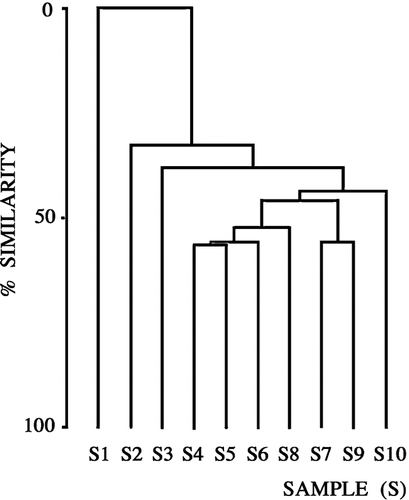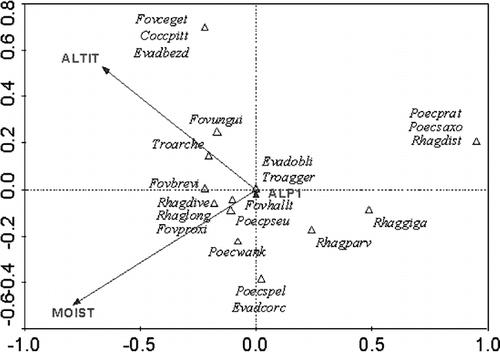Figures & data
FIGURE 1. Map of location of Obergurgl (46°52′N, 11°02′E), the Ötztal Alps, North Tyrol, Austria, showing the place of collection

FIGURE 2. A rank/relative abundance plot for ALP1 to ALP6. X-axis = species in ALP1 to ALP6 ranked from the most to least abundant. Y-axis = log10 of relative abundance (% of the total) of mites

FIGURE 3. Cluster analysis (Bray-Curtis, single linkage) of 10 samples of rhagidiid mites collected in 10 different localities (see )

FIGURE 4. Interspecific correlations as visualized by Principal Component Analysis (PCA). They are separated in four quadrats of the diagram. X-axis represents the 1st axis (λx = 0.438), Y-axis represents the 2nd axis (λy = 0.157); arrows are positions of species, and triangles are passively projected environmental centroids of alpine zones. They illustrate habitat preferences of the main species. They are: Coccorhagidia pittardi (Coccpitt), Evadorhagidia bezdezensis (Evadbezd), Evadorhagidia corcontica (Evadcorc), Evadorhagidia oblikensis (Evadobli), Foveacheles brevichelae (Fovbrevi), Foveacheles cegetensis (Fovceget), Foveacheles halltalensis (Fovhallt), Foveacheles proxima (Fovproxi), Foveacheles unguiculata (Fovungui), Poecilophysis pratensis (Poecprat), Poecilophysis pseudoreflexa (Poecpseu), Poecilophysis saxonica (Poecsaxo), Poecilophysis spelaea (Poecspel), Poecilophysis wankeli (Poecwank), Rhagidia distisolenidiata (Rhagdist), Rhagidia diversicolor (Rhagdive), Rhagidia gigas (Rhaggiga), Rhagidia longiseta (Rhaglong), Rhagidia parvilobata (Rhagparv), Troglocheles aggerata (Troagger), and Troglocheles archetypica (Troarche). Note the most extreme position of ALP1 (deeper underground scree voids) and species-empty position of ALP3 (dry Curvuletum–pasture without specific mites)

FIGURE 5. Species-environment CCA biplot diagram of the second (λx = 0.75) and third (λy = 0.35) ordinal axes of the restricted model. Explanations: arrows are significant environmental factors, ALTIT (altitude), MOIST (moisture), ALP1 (deep scree voids) together with Evadorhagidia oblikensis (Evadobli) and Troglocheles aggerata (Troagger) are in the centroid, because they are fully represented by the first ordinal axis (not visualized, λ = 1.0); triangles are species positions in ordinal space, Coccorhagidia pittardi (Coccpitt), Evadorhagidia bezdezensis (Evadbezd), Evadorhagidia corcontica (Evadcorc), Evadorhagidia oblikensis (Evadobli), Foveacheles brevichelae (Fovbrevi), Foveacheles cegetensis (Fovceget), Foveacheles halltalensis (Fovhallt), Foveacheles proxima (Fovproxi), Foveacheles unguiculata (Fovungui), Poecilophysis pratensis (Poecprat), Poecilophysis pseudoreflexa (Poecpseu), Poecilophysis saxonica (Poecsaxo), Poecilophysis spelaea (Poecspel), Poecilophysis wankeli (Poecwank), Rhagidia distisolenidiata (Rhagdist), Rhagidia diversicolor (Rhagdive), Rhagidia gigas (Rhaggiga), Rhagidia longiseta (Rhaglong), Rhagidia parvilobata (Rhagparv), Troglocheles aggerata (Troagger), and Troglocheles archetypica (Troarche)

TABLE 1 Faunal list of well recognized and verified species of Rhagidiidae that have been collected in the Alps. Patterns of distribution: (E)—endemic, (P)—Palearctic, (H)—Holarctic
TABLE 2 Alpine altitudinal zones (ALP1–ALP6) and surface sample localities (S1–S10) in the vicinity of Obergurgl, the Ötztal Alps, Austria
TABLE 3 A list of species of rhagidiid mites collected in 10 different localities (Lc1 to Lc10) in the vicinity of Obergurgl, the Ötztal Alps, Austria
TABLE 4 Values of Simpson's (D) and E1/D indexes of diversity, evenness, and species richness, respectively, for assemblages of mites collected in alpine zones ALP1 to ALP6. Note: as (D) increases, diversity decreases
TABLE 5 Permutation test of selected significant environmental variables (restricted model, variance explained by all variables = 3.15, no. of permutations = 999)
TABLE 6 Axes summary statistics for restricted model (sum of all eigenvalues = 3.384, sum of all canonical eigenvalues = 2.101)
TABLE 7 The values of correlations between the environmental variables and the ordination axes. Environmental variables: ALTIT = altitude, MOIST = moisture, ALP1 = underground interstitial scree voids. Ordination axes: SPEC = ordinal species axes, ENVI = environmental axes